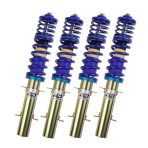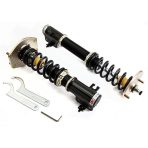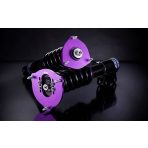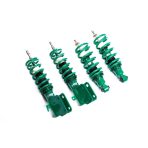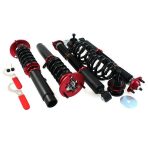Adjustable Suspension Kits
Adjustable Suspension Kits let you fine-tune ride height, damping and chassis balance for street, track or drift use. Our range covers comfort-biased and motorsport-focused coilover systems from leading brands such as AP Sportfahrwerke suspension kits, competition-ready BC Racing suspension kits and multi-line D2 Racing suspension kits. Choose the setup that matches your car and your driving style.
Overview & Key Benefits
Adjustable suspension kits offer far more control than simple lowering springs, allowing you to tailor ride height, damping and wheel travel to your usage. Threaded coilover designs provide independent height adjustment and multi-step damping so you can reduce body roll, sharpen turn-in and improve stability without sacrificing everyday usability. Across the range you will find comfort-focused street kits, firmer sport setups for track days and drift-oriented systems designed around fast weight transfer and consistent breakaway.
Technical Basics
Most adjustable suspension kits share the same core architecture: a threaded damper body, matched springs, an adjustable lower mount and a vehicle-specific top mount. Ride height is set at the lower mount, which preserves preload and usable spring travel instead of compressing the spring to lower the car. Quality kits feature multi-step—often 36-step—damping adjustment, allowing fine control over compression and rebound feel so you can dial in stability or agility as required.
Different manufacturers focus on different priorities, from OE-like refinement to track-level precision. The European all-rounder philosophy is well represented in brands such as MTS Technik suspension kits, while Japanese engineering and broad adjustability define products like TEIN suspension kits. Others target budget-friendly performance and simple tuning, giving you options at multiple price points without losing the benefits of a fully adjustable kit.
Selection Criteria
Before ordering, define your main use case: daily commuting, fast road and track days, or dedicated drift. For road-biased cars, look for softer, more compliant damping and consider rubber upper mounts to keep NVH under control. Track-oriented builds benefit from firmer support, higher spring rates and more aggressive alignment, while drift cars need valving that supports rapid weight transfer, long angles and predictable return. Brand-specific collections such as broad-coverage D2 Racing suspension kits or value-driven Turboworks suspension kits make it easier to match kit character to your project and budget.
For most mixed-use road cars a realistic drop is around 30–50 mm; going lower tends to compromise suspension geometry, reduce travel and increase the risk of bottoming or tyre-to-arch contact. You should also factor in wheel and tyre sizing (width, profile, offset) and your target alignment values. If you need significant negative camber or additional caster, you may want camber plates, eccentric bolts or adjustable arms—so choosing a kit that supports these upgrades is important for future tuning.
Installation & Maintenance
Installation quality directly influences performance and reliability. Clean all mating surfaces thoroughly, protect threads with copper grease or anti-seize and always set height via the lower mount rather than over-compressing the spring—this prevents excessive preload and binding. Torque all hardware to OE specifications and schedule a full wheel alignment (toe, camber, caster) once the car has settled on its new setup.
After the first few hundred kilometres—and after any hard track or drift session—re-torque critical fasteners and visually inspect top mounts and dust boots. If your build uses significantly wider wheels, low offsets or angle kits, check clearances regularly around arches, arms, anti-roll links and brake lines. Winter and salted-road use call for frequent rinsing and light thread protection to keep the damper bodies adjustable for future height or corner-weight changes.
FAQ
How are adjustable coilovers better than lowering springs?
A quality coilover kit lets you tune ride height, damping and travel together, rather than just dropping the car. This means better control over body roll, steering response and comfort, and the ability to adapt the setup to tyres and driving style.
How low should I go on a daily-driven car?
For most street builds a 30–50 mm drop is a good starting point. Going lower often harms suspension geometry, reduces spring travel and increases the risk of rubbing or bottoming, especially on rough roads or with passengers and luggage.
Do I need a wheel alignment after fitting an adjustable kit?
Yes—any change in height and camber will alter toe, camber and caster. Without a proper alignment the car can feel nervous, tyres may wear rapidly and it becomes harder to drive consistently at the limit.
Are pillowball top mounts suitable for daily use?
Pillowball mounts are usable on the street but increase noise and vibration. For mixed use, choose moderate damping settings and a sensible ride height, or opt for rubber tops if comfort is a high priority.
What should I check if I hear clunks at full steering lock?
Common causes include excessive preload, spring binding or interference with arms, anti-roll links or brake lines. Inspect clearances, verify torque settings, adjust height if necessary and return to a conservative baseline before further fine-tuning.

